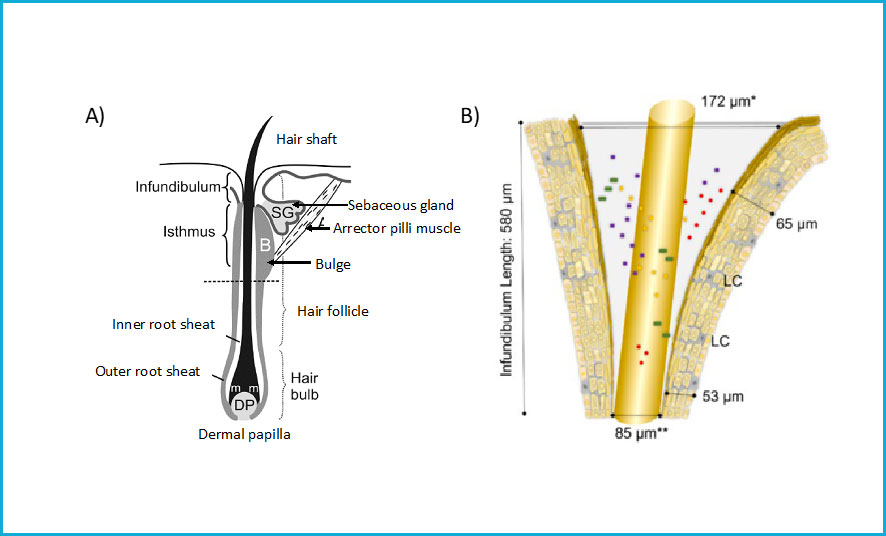Hair follicles and microbiota
The human body is colonized by trillions of microorganisms, collectively referred to as “microbiota”. In humans, microbiota inhabits diverse locations in our body such as the mouth, nasal cavities, skin, gastrointestinal tract, urogenital tract, respiratory tract, vagina, and other places. Due to advances in sequencing technologies in the last decade, a huge amount of research has demonstrated an important role of human microbiota in health and disease, particularly gut microbiota [1]. Here we will focus in hair follicle microbiota.
Human skin and hair follicles host a vast diversity of microorganisms including bacteria, viruses, fungi, and mites [2]. Microorganisms can be beneficial or pathogenic and the establishment of an equilibrium is crucial for health and disease of our skin and hair. Fortunately, the great majority of our skin and hair follicle residents are non-pathogenic and probably contribute to homeostasis by maintaining a constant dialogue with our immune system. However, stress and a variety of environmental factors are associated with microbiota imbalance.
Approximately 100,000 – 150,000 hair follicles are located in the scalp. Hair follicles are colonized by unique and complex microbiota. Fungi strain Malassezia and bacterial strains Propiobacterium, Cutibacterium, and Staphylococcus are among the most abundant microorganisms in human scalps. Compared to the skin, the hair follicle favors microbial growth because it is moist, well-perfused, relatively UV-protected and has a less acidic pH [3]. The hair follicle is an organ found in skin. There are three major segments of hair follicles: lower, middle and upper segments (Figure 1). The infundibulum covers most of the upper segment. The infundibulum is the funnel-shaped uppermost portion of the follicle. It is typically filled with sebum and debris. Due to its location, the infundibulum is a major interface zone between our skin and the environment, making it a microbiota rich place. Not surprisingly, the infundibulum is endowed with a specialized immune system. However, diverse studies have demonstrated that the infundibulum is involved in skin diseases such as acne, infundibular folliculitis, cysts, hidradenitis suppurative, keratosis pilaris, and a subtype of basal cell carcinoma [4]. An imbalance in the microbiota impacts the immune system and both are key elements in the pathogenesis of chronic scalp diseases.

A typical example of how alterations in the composition of hair follicle microbiota may impact diseases is observed in dandruff, a mild type of seborrheic dermatitis. Studies have shown that dandruff and seborrheic dermatitis are correlated with alterations in bacterial and fungal microbiota [5-8]. Similarly, microinflammation and infiltration of mononuclear cells and lymphocytes have been observed in infundibulum samples of patients with androgenetic alopecia [9]. However, further studies are needed to understand the relationship between the interactions of microbiota, hair follicle cells, and host immune system.
Microbiota varies from person to person and even within different body parts. We know that the hair follicle, especially the infundibulum is highly rich in microbiota and immune system cells. Alterations in microbiota concentrations and distributions may cause inflammation and damage to the infundibulum, deriving potentially in hair pathologies.
At CapilarFixTM we are experts at taking care of your hair follicles and your hair. We can recommend the best products that will help you maintain a balanced capilar microbiota.
References:
[1] Gilbert JA, Blaser MJ, Caporaso JG, Jansson JK, Lynch SV, Knight R, Current understanding of the human microbiome. Nat Med. 2018; 24: 392-400
[2] Oh, J., Byrd, A. L., Deming, C., Conlan, S., NISC Comparative Sequencing Program, Kong, H. H., & Segre, J. A. (2014). Biogeography and individuality shape function in the human skin metagenome. Nature, 514(7520), 59–64.
[3] Lousada, M., Lachnit, T., Edelkamp, J., Rouillé, T., Ajdic, D., Uchida, Y., Di Nardo, A., Bosch, T. and Paus, R. (2020), Exploring the human hair follicle microbiome. Br J Dermatol. Accepted Author Manuscript. doi:10.1111/bjd.19461
[4] Schneider, M. R., & Paus, R. (2014). Deciphering the functions of the hair follicle infundibulum in skin physiology and disease. Cell and tissue research, 358(3), 697–704.
[5] C. Clavaud, R. Jourdain, A. Bar‐Hen, M. Tichit, C. Bouchier, F. Pouradier, C. El Rawadi, J. Guillot, F. Menard‐Szczebara, L. Breton, J. P. Latge, I. Mouyna, Dandruff is associated with disequilibrium in the proportion of the major bacterial and fungal populations colonizing the scalp, PLoS ONE 2013, 8, e58203.
[6] L. Wang, C. Clavaud, A. Bar‐Hen, M. Cui, J. Gao, Y. Liu, C. Liu, N. Shibagaki, A. Gueniche, R. Jourdain, K. Lan, C. Zhang, R. Altmeyer, L. Breton, Characterization of the major bacterial-fungal populations colonizing dandruff scalps in Shanghai, China, shows microbial disequilibrium, Exp. Dermatol. 2015, 24, 398.
[7] R. C. Soares, P. H. Camargo‐Penna, V. C. de Moraes, R. De Vecchi, C. Clavaud, L. Breton, A. S. Braz, L. C. Paulino, Dysbiotic Bacterial and Fungal Communities Not Restricted to Clinically Affected Skin Sites in Dandruff, Front Cell. Infect. Microbiol. 2016, 6, 157.
[8] T. Park, H. J. Kim, N. R. Myeong, H. G. Lee, I. Kwack, J. Lee, B. J. Kim, W. J. Sul, S. An, Collapse of human scalp microbiome network in dandruff and seborrheic dermatitis, Exp. Dermatol. 2017, 26, 835.
[9] Mahé, Y. F., Michelet, J. F., Billoni, N., Jarrousse, F., Buan, B., Commo, S., Saint-Léger, D., & Bernard, B. A. (2000). Androgenetic alopecia and microinflammation. International journal of dermatology, 39(8), 576–584.
[10] Pisal, Rishikaysh & Dev, Kapil & Diaz, Daniel & Shaikh Qureshi, Wasay Mohiuddin & Filip, Stanislav & Mokrý, Jaroslav. (2013). Signaling Involved in Hair Follicle Morphogenesis and Development. International journal of molecular sciences. 15. 1647-70.

